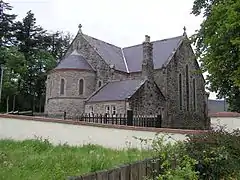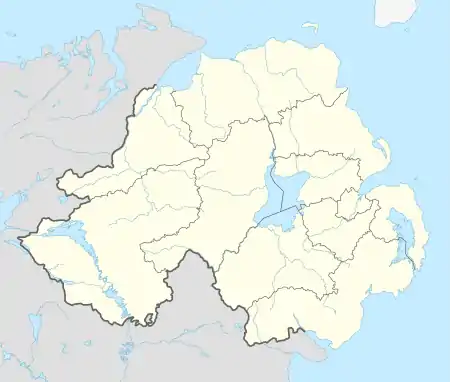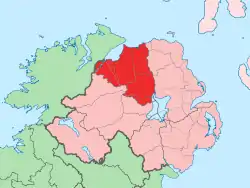Moneyneany
Moneyneany or Moneyneena (locally [ˌmʌniˈnini], [ˌmʌniˈniːnə], and [ˌmʌniˈiːnə]; from Irish: Móin na nIonadh, meaning "bog of wonders")[1][2][3] is a small village and townland in County Londonderry, Northern Ireland. In the 2001 Census it had a population of 162.[4] It is situated within Mid-Ulster District.
Moneyneany
| |
|---|---|
 St Eugene's Roman Catholic church in Moneyneany | |
 Location within Northern Ireland | |
| Population | 1,369 (2001 Census) |
| Irish grid reference | H8583 |
| District | |
| County | |
| Country | Northern Ireland |
| Sovereign state | United Kingdom |
| Post town | MAGHERAFELT |
| Postcode district | BT |
| Dialling code | 028 |
| Police | Northern Ireland |
| Fire | Northern Ireland |
| Ambulance | Northern Ireland |
| UK Parliament | |
| NI Assembly | |
Locally significant buildings include St Eugene's (Roman Catholic) Church, which is a listed building, and a fort, which is a historic monument partly encroached upon by housing, and an important feature in the landscape. The Altalacky River and the Douglas River are nearby.
Local legends
There was a holy well near the Catholic chapel at Moneyneena that was allegedly defended by a magician named Sir Volvet. The magician was so possessive of the well that he kept an earless dog chained to the well to stop others from benefiting from the water. Through time this well became known as Tobarawathymeel or "The Earless Dog’s Well".
Magical powers were not restricted to Sir Volvet; tradition has it that the townland of Moneyneany derived its name, Móin na n-ionadh ("bog of wonders"), from being a favourite place for the old Irish warriors to learn their exercises and perform great feats of magic.[5]
People
Tony Scullion, Gaelic Football and Hurling player for Ballinascreen and Derry, and receiver of four football GAA All Stars Awards, was born in Moneyneena.[6] Colonel Brian O'Neill, one of three sons of Owen Roe O'Neill who returned to Ireland with him after serving under him on the continent in 1641, was resident at Moydamlaght in the 1663 Hearth Money Rolls.
References
- Toner, Gregory: Place-Names of Northern Ireland, page 29. Queen's University of Belfast, 1996, ISBN 0-85389-613-5
- Placenames NI Archived 2011-07-27 at the Wayback Machine
- Placenames Database of Ireland
- NI Neighbourhood Information System
- History From Headstones
- All Stars Archived 2010-12-11 at the Wayback Machine GAA website Retrieved 29 June 2010
| Wikimedia Commons has media related to Moneyneany. |

